SKOWHEGAN — Another round of cash infusion for the planned $4.96 million Run of River white-water recreation park in downtown Skowhegan was approved Tuesday night when the Board of Selectmen accepted almost $100,000 for the project.
The unanimous vote means $93,000 will be deposited from Main Street Skowhegan into the Run of River Reserve Account. The board also approved spending $24,650 from the same account for permits and additional data gathering in the downtown Kennebec River gorge, including a survey of the riverbed and an inspection of the gorge to determine the location of debris from the railroad bridge that washed away during the flood of 1987. Data collection is expected to happen within the next eight weeks.
The funding comes in conjunction with a vote by Somerset County commissioners Nov. 7 to award the project $40,000 from the Community Benefit Account. Commissioners at the same meeting agreed to award Maine Huts and Trails $35,000 from the county tax increment financing (TIF) district and to award $6,667 for the TIF account and $13,333 from the Community Benefit Fund for the West Forks Fire Department.
Selectmen in June 2017 agreed to establish the Run of River Reserve Account for grants and donations.
“At that meeting they also accepted $15,000 from the Davis Family Foundation, which went into that account,” Town Manager Christine Almand said Tuesday before the meeting. “Most of that amount has been paid to John Anderson Architect, LLC for pre-permitting services.”
Board Chairman Paul York asked if the proposed “second bridge” over the Kennebec, if it ever is approved, would affect the project.
Greg Dore, Skowhegan’s road commissioner and a member of the Run of River Committee, said the bridge project actually might benefit the river park with added money for environmental mitigation.
Kristina Cannon, executive director at Main Street Skowhegan, said in July that the project has been promised $25,000 from the Quimby Family Foundation and a matching $25,000 from the Maine Community Foundation’s donor-advised fund, as well as another $15,000 donated last year for the study of the river bottom en route to permitting.
Most of the money is to be used for “next step” additions to the white-water plan, which calls for the creation of white-water waves at man-made structures in three locations along the Kennebec River to attract boaters for a park-and-play destination, waves for surfers and body boarders and an 1,800-foot run for rafting and kayaking.
“Fundraising for Run of River is gaining traction, and it’s so exciting,” Cannon said Tuesday. “We are thrilled that the county TIF committee recognizes the value of the proposed white-water park and trail system and the positive impact they will have on recreational tourism and economic development in the region.”
The project also would improve physical and visual access to the gorge by creating two footpaths down to the river and terraced seating along the shore. Planning began for the park in 2004, and local officials finally saw a digital model of the park in February 2014.
An economic impact study released in 2016 predicted the project could generate $6 million in revenue and 43 new local jobs in just the first year of operation.
The study, released by Planning Decisions Inc., of Hallowell, in conjunction with Main Street Skowhegan, notes the project, with its man-made bumps and white-water rapids, also could produce as much as $19 million and as many as 136 local jobs in its 10th year of operation.
The “play park” for paddling, canoeing, kayaking and tubing, with added four-season amenities of trails, competitions and spectator posts along the river route, also would generate an estimated $155,000 in new tax revenue from increased property values in the first year and more than $200,000 in added state income- and sales-tax revenue, according to the study.
An $80,000 U.S. Department of Agriculture rural business opportunity grant was used to complete engineering on a digital model of the park, a requirement for the many permits the park will need. The model will have to pass scrutiny of the permitting agencies, including the state Department of Environmental Protection, the Army Corps of Engineers, and the Department of Inland Fisheries & Wildlife.
Cannon said with the money raised for 3D modeling, the next fundraising goal is $180,000 to cover the costs of the required permits. The Run of River Committee is applying for grants and researching other possible funding sources, with the intention of beginning permitting in the spring of 2019, she said.
The state’s Indian tribes and Maine historic preservation groups also will weigh in on the project. After the permitting, bidding for the work will follow, then construction. The goal is to begin construction in the summer of 2021, when Brookfield Renewable power company plans to lower the river for construction of a fish passage ladder.
“We still have quite a bit of money left to raise, but the momentum is building and we’re up to the challenge because this is an important project for the town, the county, and the state,” Cannon said.
Doug Harlow — 612-2367
Twitter:@Doug_Harlow
Send questions/comments to the editors.




